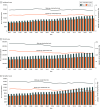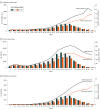Burden of Central Nervous System Cancer in the United States, 1990-2021
- PMID: 41182787
- PMCID: PMC12584065
- DOI: 10.1001/jamaneurol.2025.4286
Burden of Central Nervous System Cancer in the United States, 1990-2021
Abstract
Importance: Primary brain and central nervous system cancer (collectively referred to as CNS cancer) comprises 2% of all human cancers and poses significant health and economic challenges in the United States.
Objective: To analyze CNS cancer burden in the US, stratified by time, location (state and division), sex, age group, and Sociodemographic Index (SDI).
Design, setting, and participants: This cross-sectional study involved a repeated analysis of Global Burden of Disease Study (GBD) 2021 data in 2024. Using data from 183 sources, CNS cancer metrics in the US were estimated across states and years. US CNS cancer metrics across all sexes and age groups were included in the GBD.
Exposure: CNS cancer diagnosis.
Main outcomes and measures: Overall and age-standardized estimates of the incidence, prevalence, mortality, disability-adjusted life-years (DALYs), years of life lost, and years lived with disability per 100 000 population, including 95% uncertainty intervals (UIs), and time trends.
Results: In 2021, for all age groups and sexes across the US, there were 31 780 incident cases (95% UI, 29971.1 to 32843.9). Age-standardized incidence, DALYs, and mortality rates per 100 000 population were 6.91 (95% UI, 6.58 to 7.12), 134.38 (95% UI, 129.83 to 137.95), and 4.1 (95% UI, 3.87 to 4.22), respectively. Despite no significant change observed in the overall incidence between 1990 and 2021, DALY and mortality rates decreased by 15.77% (95% UI, -17.75% to -13.68%) and 8.41% (95% UI, -11.09% to -6.22%), respectively. Substantial geographic variability was noted. Mississippi, Alabama, Kentucky, and Kansas (West North Central and East South Central divisions) and West Virginia faced persistently high burdens over the past 30 years. Sex differences were evident; disease burden was consistently higher in males compared with females. Age-specific estimates showed a bimodal distribution: the youngest group (<5 years) showed a significant decrease in incidence rate (-34.42% to -11.56%), whereas older age groups (>70 years) experienced increasing trends. DALYs and mortality rates were negatively correlated with SDI (ρ = -0.6860 and ρ = -0.6391; P < .001).
Conclusions and relevance: These findings provide valuable insights into the CNS cancer burden across the US by age, sex, location, and SDI, enabling better public health status assessments, health care policy restructuring, and resource redistribution for improved care.
Conflict of interest statement
Figures




References
-
- Khanmohammadi S, Mobarakabadi M, Mohebi F. The economic burden of malignant brain tumors. In: Rezaei N, Nanaei S, eds. Human Brain and Spinal Cord Tumors: From Bench to Bedside Volume 1: Neuroimmunology and Neurogenetics. Springer; 2023:209-221. - PubMed
LinkOut - more resources
Full Text Sources
Miscellaneous

